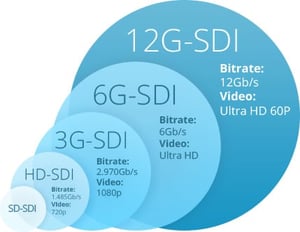WHY DOES AV NEED 12G SDI?

WHAT IS SDI?
SDI = Serial Digital Interface. In 1989, The Society of Motion Picture and Television Engineers ( SMPTE ) announced a new digital video format for the broadcast industry, used for mostly uncompressed content in TV studios and production facilities.
The first format was simply called SDI, and could carry enough info for a standard 480P TV stream.

Next came HD-SDI (obvious purpose), then higher speed formats to carry UHD, 4K, 8K), higher bitrates and more colors. In 2015 came 6G SDI and 12G SDI.
WHY WOULD I USE SDI?
Why use an SDI format when there are so many others to choose from? Good question! Mostly boils down to ease of use and robust uncompressed performance. That would include – at 12G SDI – support for 4K 60/8K 30.
Here are things that come with using the SDI format:
- Cable length
- Fiber
- Robust connectors and cabling (BNC on coaxial cable)
- Uncompressed audio and video
- No HDCP
- Embedded time-code
- No latency
- Ancillary data support
- Embedded audio (up to 32 channels)
- Cost
Note that SDI also comes with its own cabling system. This will be a pro or a con, depending on how much you like your CATx cabling and connectors. This coaxial cable, paired with easy to install, locking, push and turn BNC connectors, is a highly secure combination. HDMI connectors are child’s toys next to this setup.
Lastly, cost is also a plus, as SDI equipment is reasonably priced, and has the ability to push all of these signals over cable lengths that top out above 300′ with coax, and 32,000′ with fiber.
Next up? 24G-SDI, supporting 8K 120 resolution.
Conclusion: SDI is something every AV and video salesperson should be familiar with, and ready to use when the need arises. It is a vital tool in any designer’s set.

